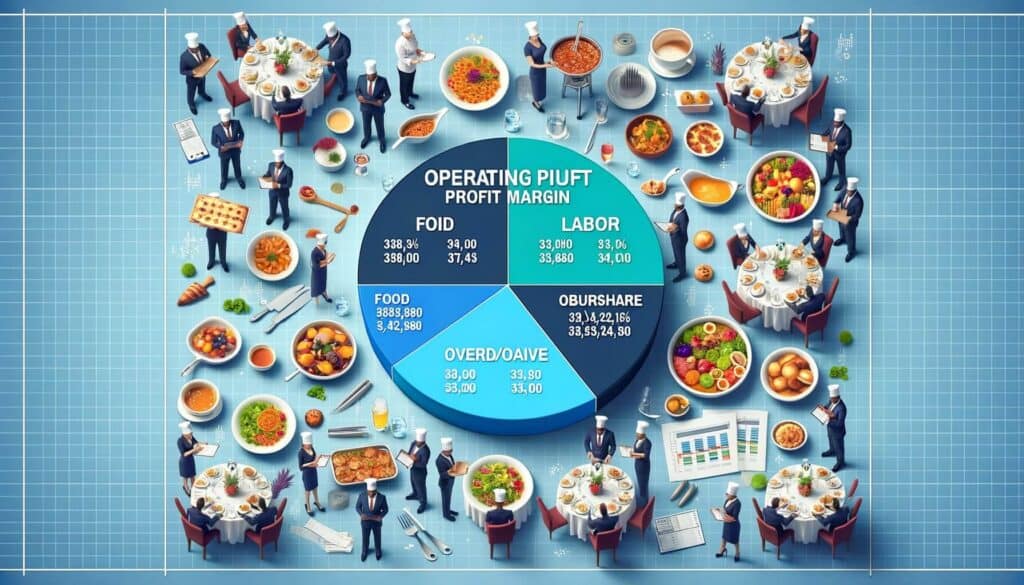
By Jermaine Thomas March 18, 2025
Profitability is a crucial aspect of any business, and the catering industry is no exception. In order to thrive and succeed in this competitive field, catering businesses must carefully assess their profitability and make informed decisions based on key metrics and financial benchmarks.
By understanding and analyzing these metrics, catering businesses can identify areas of improvement, optimize their operations, and ultimately increase their profitability.
Key Metrics for Assessing Profitability in Catering

When it comes to assessing profitability in catering, there are several key metrics that businesses should consider. These metrics provide valuable insights into the financial health of the business and help identify areas that may be impacting profitability. Let’s take a closer look at some of these key metrics:
1. Gross Profit Margin: The gross profit margin is a measure of how much profit a catering business makes after deducting the cost of goods sold (COGS). It is calculated by dividing the gross profit by the total revenue and multiplying by 100. A higher gross profit margin indicates that the business is generating more profit from each dollar of revenue.
2. Operating Profit Margin: The operating profit margin measures the profitability of a catering business after deducting both the COGS and operating expenses. It is calculated by dividing the operating profit by the total revenue and multiplying by 100. This metric provides insights into the efficiency of the business’s operations and its ability to control costs.
3. Return on Investment (ROI): ROI is a measure of the profitability of an investment. In the catering industry, ROI can be calculated by dividing the net profit by the total investment and multiplying by 100. This metric helps catering businesses assess the profitability of specific investments, such as purchasing new equipment or expanding their operations.
4. Cost of Goods Sold (COGS): COGS refers to the direct costs associated with producing the goods or services provided by a catering business. This includes the cost of ingredients, packaging, and any other materials used in the production process. By tracking and analyzing COGS, catering businesses can identify opportunities to reduce costs and improve profitability.
5. Labor Costs and Efficiency: Labor costs are a significant expense for catering businesses, and managing them effectively is crucial for profitability. By tracking labor costs and analyzing labor efficiency metrics, such as labor cost per hour or labor cost as a percentage of revenue, businesses can identify areas where labor costs can be optimized and productivity can be improved.
Understanding Financial Benchmarks in the Catering Industry

Financial benchmarks are industry-specific standards that help catering businesses assess their financial performance and compare it to industry averages. These benchmarks provide valuable insights into how a business is performing relative to its competitors and can help identify areas for improvement. Some common financial benchmarks in the catering industry include:
1. Average Gross Profit Margin: The average gross profit margin in the catering industry can vary depending on factors such as the type of catering business and its target market. However, a benchmark range of 50% to 60% is generally considered healthy for most catering businesses.
2. Average Operating Profit Margin: The average operating profit margin in the catering industry is typically lower than the gross profit margin due to the inclusion of operating expenses. A benchmark range of 10% to 15% is considered favorable for catering businesses.
3. Average Return on Investment (ROI): The average ROI in the catering industry can vary depending on the specific investment being analyzed. However, a benchmark range of 15% to 20% is generally considered a good return on investment for catering businesses.
Analyzing Gross Profit Margin in Catering

The gross profit margin is a key metric for assessing profitability in the catering industry. It provides insights into how much profit a catering business is generating from each dollar of revenue after deducting the cost of goods sold. Analyzing the gross profit margin can help businesses identify areas where costs can be reduced and profitability can be improved.
To calculate the gross profit margin, catering businesses need to subtract the cost of goods sold from the total revenue and divide the result by the total revenue, then multiply by 100. For example, if a catering business has a total revenue of $100,000 and a cost of goods sold of $40,000, the gross profit margin would be calculated as follows:
Gross Profit Margin = (Total Revenue – Cost of Goods Sold) / Total Revenue * 100
Gross Profit Margin = ($100,000 – $40,000) / $100,000 * 100
Gross Profit Margin = $60,000 / $100,000 * 100
Gross Profit Margin = 60%
In this example, the catering business has a gross profit margin of 60%. This means that for every dollar of revenue generated, the business is making a gross profit of 60 cents.
Evaluating Operating Profit Margin in Catering

The operating profit margin is another important metric for assessing profitability in the catering industry. It takes into account both the cost of goods sold and the operating expenses of a catering business. By analyzing the operating profit margin, businesses can gain insights into their operational efficiency and their ability to control costs.
To calculate the operating profit margin, catering businesses need to subtract both the cost of goods sold and the operating expenses from the total revenue and divide the result by the total revenue, then multiply by 100. For example, if a catering business has a total revenue of $100,000, a cost of goods sold of $40,000, and operating expenses of $30,000, the operating profit margin would be calculated as follows:
Operating Profit Margin = (Total Revenue – Cost of Goods Sold – Operating Expenses) / Total Revenue * 100
Operating Profit Margin = ($100,000 – $40,000 – $30,000) / $100,000 * 100
Operating Profit Margin = $30,000 / $100,000 * 100
Operating Profit Margin = 30%
In this example, the catering business has an operating profit margin of 30%. This means that for every dollar of revenue generated, the business is making an operating profit of 30 cents after deducting both the cost of goods sold and the operating expenses.
Assessing Return on Investment (ROI) in Catering
Return on Investment (ROI) is a crucial metric for assessing the profitability of investments in the catering industry. Whether it’s purchasing new equipment, expanding operations, or investing in marketing campaigns, catering businesses need to carefully evaluate the potential return on their investments to ensure they are making sound financial decisions.
To calculate ROI, catering businesses need to subtract the total investment from the net profit and divide the result by the total investment, then multiply by 100. For example, if a catering business has a net profit of $50,000 and a total investment of $200,000, the ROI would be calculated as follows:
ROI = (Net Profit – Total Investment) / Total Investment * 100
ROI = ($50,000 – $200,000) / $200,000 * 100
ROI = -$150,000 / $200,000 * 100
ROI = -75%
In this example, the catering business has a negative ROI of 75%. This means that the investment has not generated a positive return and has resulted in a loss for the business. It is important for catering businesses to carefully evaluate the potential ROI of investments before making any financial commitments.
Measuring Cost of Goods Sold (COGS) in Catering
The cost of goods sold (COGS) is a critical metric for measuring profitability in the catering industry. It represents the direct costs associated with producing the goods or services provided by a catering business. By tracking and analyzing COGS, catering businesses can identify opportunities to reduce costs and improve profitability.
COGS includes the cost of ingredients, packaging, and any other materials used in the production process. It does not include indirect costs such as labor, rent, or utilities. By separating direct costs from indirect costs, catering businesses can gain a clearer understanding of their profitability and make informed decisions to optimize their operations.
To calculate COGS, catering businesses need to add up the cost of all the ingredients and materials used in the production process. For example, if a catering business uses $10,000 worth of ingredients and materials to produce its goods or services, the COGS would be $10,000.
Tracking Labor Costs and Efficiency in Catering
Labor costs are a significant expense for catering businesses, and effectively managing them is crucial for profitability. By tracking labor costs and analyzing labor efficiency metrics, catering businesses can identify areas where labor costs can be optimized and productivity can be improved.
There are several key labor cost metrics that catering businesses should track:
1. Labor Cost per Hour: This metric measures the average cost of labor per hour worked. By dividing the total labor costs by the total number of hours worked, catering businesses can determine the average cost of labor per hour. Tracking this metric over time can help identify trends and fluctuations in labor costs.
2. Labor Cost as a Percentage of Revenue: This metric measures the proportion of revenue that is spent on labor costs. By dividing the total labor costs by the total revenue and multiplying by 100, catering businesses can determine the percentage of revenue that is allocated to labor costs. This metric helps assess the efficiency of labor utilization and its impact on profitability.
3. Labor Productivity: Labor productivity measures the output or value generated by each unit of labor input. By dividing the total revenue by the total number of labor hours worked, catering businesses can determine the productivity of their labor force. This metric helps identify areas where productivity can be improved and labor costs can be optimized.
Managing Overhead Expenses in Catering
Overhead expenses are indirect costs that are not directly tied to the production of goods or services in the catering industry. These expenses include rent, utilities, insurance, marketing, and administrative costs. Managing overhead expenses effectively is crucial for improving profitability in the catering industry.
There are several strategies that catering businesses can employ to manage overhead expenses:
1. Negotiate Lease Agreements: Rent is often one of the largest overhead expenses for catering businesses. By negotiating favorable lease agreements with landlords, businesses can reduce their monthly rent and free up cash flow for other purposes.
2. Implement Energy-Saving Measures: Utilities can be a significant overhead expense for catering businesses. By implementing energy-saving measures, such as using energy-efficient appliances and optimizing heating and cooling systems, businesses can reduce their utility bills and lower their overhead expenses.
3. Optimize Marketing Expenses: Marketing is essential for attracting new customers and growing a catering business. However, it is important to optimize marketing expenses to ensure a positive return on investment. By analyzing the effectiveness of different marketing channels and focusing on those that generate the highest return, businesses can reduce unnecessary marketing expenses and improve profitability.
4. Streamline Administrative Processes: Administrative costs, such as accounting and payroll, can add up quickly for catering businesses. By streamlining administrative processes and leveraging technology, businesses can reduce administrative costs and improve efficiency.
Utilizing Financial Ratios for Profitability Analysis in Catering
Financial ratios are powerful tools for analyzing profitability in the catering industry. They provide insights into the financial health of a business and help identify areas for improvement. By comparing financial ratios to industry benchmarks and historical data, catering businesses can gain a deeper understanding of their profitability and make informed decisions.
Some common financial ratios used in profitability analysis in the catering industry include:
1. Current Ratio: The current ratio measures a business’s ability to meet its short-term obligations. It is calculated by dividing current assets by current liabilities. A current ratio of 2 or higher is generally considered favorable for catering businesses.
2. Quick Ratio: The quick ratio, also known as the acid-test ratio, measures a business’s ability to meet its short-term obligations without relying on inventory. It is calculated by dividing current assets minus inventory by current liabilities. A quick ratio of 1 or higher is generally considered favorable for catering businesses.
3. Debt-to-Equity Ratio: The debt-to-equity ratio measures the proportion of a business’s financing that comes from debt compared to equity. It is calculated by dividing total debt by total equity. A lower debt-to-equity ratio indicates a lower level of financial risk for catering businesses.
4. Return on Assets (ROA): ROA measures a business’s ability to generate profit from its assets. It is calculated by dividing net profit by total assets. A higher ROA indicates a more efficient use of assets and higher profitability for catering businesses.
5. Return on Equity (ROE): ROE measures a business’s ability to generate profit from its shareholders’ equity. It is calculated by dividing net profit by total equity. A higher ROE indicates a higher return on investment for shareholders.
Conclusion
Profitability is a critical aspect of running a successful catering business. By understanding and analyzing key metrics and financial benchmarks, catering businesses can gain valuable insights into their financial performance and make informed decisions to improve profitability.
From assessing gross profit margin and operating profit margin to evaluating return on investment and managing overhead expenses, each metric plays a crucial role in profitability analysis.
By utilizing financial ratios and tracking labor costs and efficiency, catering businesses can optimize their operations and increase their profitability. With a comprehensive understanding of profitability in catering and a focus on key metrics, catering businesses can thrive in this competitive industry.